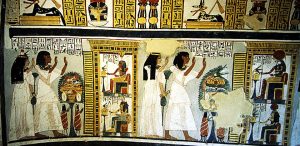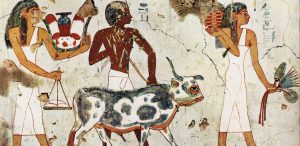+20 2 3762 0904 / +372 5923 9322 /
+44 745 225 4645
Introducción sobre Las Tumbas de los Nobles
Debido a la gran riqueza arqueológica de Luxor con impresionantes vestigios del Antiguo Egipto, algunos de los sitios históricos de menor tamaño, pero no menos importantes, pasan desapercibidos.
Las Tumbas de los Nobles es una necrópolis que contiene más de 500 tumbas privadas de nobles y altos oficiales, durante el Reino Medio y el Reino Nuevo, con magníficas escenas pintadas en sus paredes que muestran diferentes aspectos de la vida diaria en el Antiguo Egipto.
Ubicación Geográfica
Las Tumbas de los Nobles están situadas en la Ribera Occidental de Luxor, al sur del Valle de los Reyes y al norte del Valle de las Reinas.
Se puede acceder fácilmente en taxi o vehículo privado.
Historia y Descripción
No se conoce exactamente el comienzo de los entierros en el área donde están las Tumbas de los Nobles. Sin embargo, se estima que fue durante el siglo XVIII a.C. cuando se empezaron a excavar las tumbas. Éstas están divididas en diferentes secciones: la primera se encuentra en la entrada del valle, que conduce a la famosa necrópolis histórica del Valle de los Reyes. Esta área alberga las necrópolis de Dra Abu El Naga y El Tarif, donde hay interesantes tumbas del siglo XVIII a.C.
Cerca del Templo de Hatshepsut, están las necrópolis de El Khokha y El Asasif. Tiene tumbas de los siglos XVIII y XIX a.C. También, algunas tumbas notables de las Dinastías XXV y XXVI.
La sección más grande es la de Abdel Qurna, ubicada en la ladera de la montaña cercana al Ramesseum, el templo mortuorio del faráon Ramsés II. Esta necrópolis tiene diversas tumbas, la mayoría de ellas pertenecen a la Dinastía XVIII y cuentan con increíbles paredes pintadas de colores brillantes, muy bien preservadas.
La estructura de Las Tumbas de los Nobles es bastante sencilla, en comparación a las complejas estructuras del Valle de los Reyes y de las Reinas. La construcción consiste en una capilla de culto y una sala funeraria. La capilla se comunica con un vestíbulo que conduce a un patio en forma de “T”. La cámara funeraria puede alcanzarse través de una abertura en la capilla.
Entre las tumbas más destacadas podemos destacar la de Nakht, quien trabajó en el campo de la Astronomía, durante el reinado de Tutmosis VI, en el siglo XIX a.C.
La tumba de Menna se caracteriza por sus hermosas paredes pintadas representando al difunto supervisando los trabajos agrícolas en los campos reales.
Otro ejemplo es la tumba de Ahmose, quien vivió durante el reinado de Amenhotep IV, y contiene maravillosos bajorrelieves. Esta tumba es la más grande de toda la necrópolis y su tamaño se debe a que Ahmose fue el visir del rey y por tanto, su lugar de entierro debía reflejar su alta posición en el reino.
La tumba de Sennefer, uno de los gobernantes durante el reino del faraón Amenhotep II, es una de las tumbas mejor preservadas de la zona.
La tumba de Rakhmire, un visir durante los reinados de Tutmosis III y Amenhotep II contiene hermosas pinturas en sus paredes.
No te pierdas la oportunidad de conocer Las Tumbas de los Nobles!
Due to the richness of the Luxor city monuments, especially the scenes of the historical site situated on the West Bank of the River Nile, many remarkable monuments are rather far less visited by tourists spending their vacation in Egypt. One of these tours had to be for the monuments of the Tomb of the Nobles.
Although this wonderful ancient necropolis with its marvelous wall paintings demonstrates almost all the aspects of life in ancient Egypt, many of the travelers miss it during their tours in Egypt.
This necropolis will guide you to more 500 private tombs of the nobles and high officials of ancient Egypt during the reign of the New Kingdom and the Middle Kingdom mainly from the 18th to the 20th centuries BC.
Situated in the middle between the Valley of the Kings site to the North and the Valley of the Queens site to the North, The Tombs of the Nobles can easily be reached by any taxi in the West Bank of Luxor.
Many travelers spending their tours in Egypt can ask their travel company to add a visit to the Tombs of the Nobles site during their tours in Luxor as almost all travel packages usually exclude the Tombs of the Nobles from their itineraries.
It is simply a fact of life, even until today, that all people would rather be near the kings and the royal family of the country. This was why exactly happened in the Tombs of the Nobles as the military chiefs, nobles, and high officials desired to be buried near to the royal family in the West Bank of Luxor.

The Tombs of the Nobles Egypt are today divided into different sections in various places around the West Bank of Luxor. A number of tourists having tours in Egypt, especially those who love to visit historical sites that only a few numbers of people visited, explore the tombs of the nobles site in Luxor.

Near the marvelous mortuary Temple of Hatshepsut , there are the ancient necropolises named as El Khokha and El Asasif. They host many tombs from the 18th and 19th centuries. This is besides the remarkable 25th dynasty and 26th dynasty large tombs that are situated there.
In fact, the largest and most important section of the Tombs of Noble’s site is that area named Abdel Qurna that is located inside a mountain near the Ramesseum, the mortuary temple of the royal Ramses II. This necropolis has many tombs that mainly belong to the 18th dynasty and they are featured with their amazing colorful wall paintings that are well preserved until today.
Mainly the structure of the tombs was rather quite simple in comparison to the complex structure of the Valley of the Kings and the Valley of the Queens situated nearby.
The structure consists of two sections decorated in a special way; the first is the cult chapel while the second was the burial chamber. The cult chapel opens to a vestibule that opens towards a courtyard forming the shape of the letter, (T). The burial chamber can be reached through a cut into the wall of the cult chapel.
As the tombs of the nobles include about 500 tombs we will guide you to the most famous and interesting tombs that you can visit during your tours in Luxor.


The tomb of Menna is decorated with its remarkable walls paintings of the deceased supervising the agriculture work scenes in the royal fields.

The tomb of Ahmos is factually the largest tomb in the whole ancient necropolis of the Tombs of the Nobles in Luxor. This was due to the fact that Ahmos was the Vizier of the king and his tomb had to be relatively large to reflect his high position in the kingdom.
Other great examples of the tombs of the Nobles of Luxor would include the tomb of Sennfer; the mayor of Thebes in the ruling time of king Amenhotep II and it is one of the best-preserved tombs in the area.
This is besides the tomb of Rekhmire, a vizier during the reigns of kings Tuthmosis III and Amenhotep II that is featured with wonderful wall paintings.
Tourists spending their tours in Egypt should always pay attention to which sites they would like to explore in the land of the Nile. Travelers can book a tour where they have the major sites included and then add the optional tours to any historical sites they wish to visit afterward like the Tombs of the Nobles.